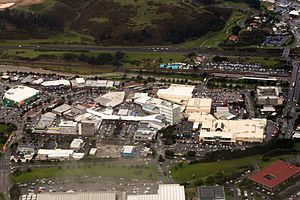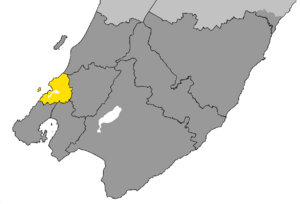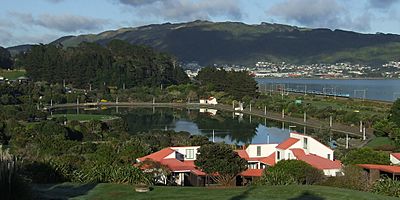Porirua facts for kids
Quick facts for kids
Porirua
Pari-ā-Rua
|
|
|---|---|
|
City
|
|

Aerial view of Porirua City Centre and Porirua Station (upper right)
|
|
| Motto(s): | |
 |
|
| Country | New Zealand |
| Region | Wellington |
| Wards |
|
| Electorates | Mana (general) Te Tai Hauāuru (Māori) |
| Government | |
| • Type | City council |
| Area | |
| • Territorial | 174.80 km2 (67.49 sq mi) |
| • Urban | 60.98 km2 (23.54 sq mi) |
| • Rural | 113.82 km2 (43.95 sq mi) |
| Population
(June 2023)
|
|
| • Territorial | 62,400 |
| • Density | 356.98/km2 (924.6/sq mi) |
Porirua, (Māori: Pari-ā-Rua) a city in the Wellington Region of the North Island of New Zealand, is one of the four cities that constitute the Wellington metropolitan area. The name 'Porirua' is a corruption of 'Pari-rua', meaning "the tide sweeping up both reaches". It almost completely surrounds Porirua Harbour at the southern end of the Kapiti Coast. As of June 2023 Porirua had a population of 60,900 .
Contents
History
The name "Porirua" has a Māori origin: it may represent a variant of pari-rua ("two tides"), a reference to the two arms of the Porirua Harbour. In the 19th century the name designated a land-registration district that stretched from Kaiwharawhara (or Kaiwara) on the north-west shore of Wellington Harbour northwards to and around Porirua Harbour. The road climbing the hill from Kaiwharawhara towards Ngaio and Khandallah still bears the name "Old Porirua Road".
In the 19th century a small European settlement grew up, partly because of the need for a ferry across the harbour. At the time a small Māori settlement already existed.
The Wellington and Manawatu Railway Company opened a railway line to Porirua in 1885, linking the city with Wellington. The railway reached Longburn (south of Palmerston North) in 1886 to connect with the Government's lines to Taranaki and Napier. With the acquisition of the company by the government in 1908, the line to Porirua formed part of the North Island Main Trunk railway. The railway contributed much to the growth of Plimmerton and Paremata by making day-trips to the beaches from Wellington relatively easy. The line through to Porirua was electrified in 1940 following the construction of the Tawa Flat deviation.
The 1880s and 1890s saw the establishment of the Porirua Lunatic Asylum on the hill south-west of the village. Following the Mental Defectives Act of 1911, the Asylum became Porirua Mental Hospital.
In the late 1940s state planning envisaged Porirua becoming a satellite city of Wellington with state housing. Since then Porirua has grown to a city population approaching 51,000, with state housing no longer in the majority. Major territorial additions to the city occurred in 1973 and 1988 as part of the reduction and eventual abolition of Hutt County.
Substantial industrial areas, generally west of the city centre, have evolved. During the 1960s Kodak, UEB Industries and many small businesses opened at Elsdon. During the following decade, Ashley Wallpapers developed the former UEB property and after favourable negotiations with the government, Todd Motors (later Mitsubishi) moved from Petone to Porirua.
On 7 June 1976, New Zealand's first McDonald's restaurant opened in Porirua, on the corner of Cobham Court and Hagley Street. The original restaurant closed on 24 April 2009, and the store relocated to Kenepuru Drive.
Coat of Arms
The City has a Coat of Arms and the Blazon is: Vert two Piles Barry wavy of ten Argent and Azure and for the Crest on a Wreath of the Colours in front of a Lymphad proper Sail set Pennon flying Gules Flags flying Azure a Whale proper. Supporters: on the dexter side a Private Soldier of the 58th Regiment of Foot in the uniform of the early Nineteenth Century and on the sinister side a Maori Warrior both proper.
Translation of the Blazon. The shield is the most important part and is first described. “Vert” means green so that is the base colour of the shield. Then the objects on the shield are described. A “Pile” is V shaped object and there are two of them. “Barry” means the piles are divided into an even number of lines in this case ten. The lines are “wavy” like the sea and are alternatively coloured silver (“Argent”) and blue (“Azure”.) Silver is usually depicted as white.
The crest is the part above the shield, excluding the helmet. The wreath is twist of cloth and the colours are those already mentioned vis white and green. A “Lymphad” is a sailing ship and “proper” means it is shown in its natural colours. The sail is set for sailing and a “Pennon” is the long flag flying from the mast and being “gules” it is red. The smaller flags are blue (“azure”) and are also flying. In front of the ship is a whale and again “proper” means it is shown in its natural colours.
The Supporters are the men on either side of the shield. The dexter side is the right from the shield carrier’s point of view but to the left for an observer. They are as described in the blazon and are too are depicted in their natural colours.
Neither the mantelling nor the motto are normally part of the blazon. However the motto of "Mo Te Katoa Nga mahi" may be translated as "All That is Done is For the Benefit of All".
Suburbs
Porirua is largely formed around the arms of the Porirua Harbour and the coastline facing out to Cook Strait and the north-eastern parts of the South Island. Most of the populated areas of Porirua are coastal: Camborne, Karehana Bay, Mana, Onepoto, Papakowhai, Paremata, Pauatahanui, Plimmerton, Pukerua Bay, Takapuwahia, Titahi Bay and Whitby all have direct access to coastal parks and recreation reserves. Several suburbs without direct coastal access, including Aotea, Ascot Park and Ranui Heights, have substantial portions with good views over the harbour. Elsdon, formerly known as Prosser Block, lost access to the harbour as a result of reclamation work, especially during the 1960s. Much of the existing city centre, north of Parumoana Street and east of Titahi Bay Road, was built upon this landfill.
Suburbs include:
- Aotea
- Ascot Park
- Camborne
- Cannons Creek
- Elsdon – named after writer Elsdon Best
- Golden Gate – a local name for the eastern part of Paremata
- Hongoeka Bay – a Ngāti Toa settlement
- Karehana Bay
- Kenepuru – industrial area south-west of the centre, adjoining Linden
- Mana
- Onepoto
- Papakowhai – a locality where kowhai trees are prominent on headlands
- Paremata – probably named after Sydney's Parramatta
- Pauatahanui
- Plimmerton – named for a director of the railway company
- Porirua East
- Pukerua Bay – where film-maker Peter Jackson grew up
- Ranui Heights
- Takapuwahia – a Ngāti Toa settlement
- Titahi Bay – where pro golfer Michael Campbell grew up
- Waitangirua
- Whitby – street names commemorate James Cook
Rural localities include Judgeford and Horokiri.
Transport
State Highway 59 is the main route through Porirua itself, passes north–south through the middle of the city, linking Porirua southwards to Wellington and northwards to the Kapiti Coast and the bulk of the North Island. Porirua is the northern terminus of the Johnsonville–Porirua motorway (opened progressively from 1950), with the section of motorway within Porirua being part of the SH 59 route. Until 7 December 2021, the SH 59 route was part of State Highway 1.
State Highway 1, the most significant route in the New Zealand state highway network, forms an eastern bypass of Porirua as the Transmission Gully Motorway. There are link roads between the Transmission Gully Motorway and Kenepuru, Waitangirua and Whitby.
State Highway 58 links Paremata via Whitby and Pāuatahanui (where an interchange with the Transmission Gully Motorway is located) with Haywards in the Hutt Valley to the east.
The Ara Harakeke is a pathway that runs alongside SH 59 and the Taupō Swamp, north of Plimmerton. The first section was opened in 2002. Porirua City Council won a Cycle Friendly Award for this project from the Cycling Advocates' Network in 2003.
The North Island Main Trunk railway line passes through Porirua, mostly close to State Highway 59, with six stations including the main Porirua Railway Station inside the city and one on the Wellington City border. The railway stations from south to north are Kenepuru, Porirua, Paremata, Mana (known as Dolly Varden before 1960), Plimmerton, Pukerua Bay, and Muri (closed 30 April 2011). Kapiti Line suburban passenger trains run between Wellington and Waikanae (generally half-hourly during the day before 15 July 2018 and every twenty minutes during the day after that date, more frequently during peak periods, and less frequently at night). The Northern Explorer long-distance passenger train between Auckland and Wellington passes through Porirua. This train was known as the Overlander before 25 June 2012 which stopped southbound but not northbound.
The nearest airports are Wellington Airport to the south (the closest), and Paraparaumu Airport to the north.
Ferry services ran between Paremata and Picton for short periods but appeared unable to compete with Wellington-based services despite the shorter distance.
Arts and culture
The local culture, history and artists are represented at the Pataka Museum of Arts & Cultures located conveniently next to the public library.
The indie rock radio station andHow.FM broadcasts locally at 107.5 FM from the suburb of Papakowhai.
Sport and recreation
As early as 1883, Porirua began to hold regular horse racing events on the harbour's Southern beach. Towards the end of a meeting, competing riders would also have to combat the incoming tide. The Porirua Jockey Club was quickly established with Mr W. Jillett the first secretary and local butcher, John Rod, the treasurer. Joshua Prosser built stables on his nearby property 'Prosser Block' (now Elsdon) and became a notable trainer of Dominion race-horses. The beach now lies beneath Porirua city centre.
Porirua is home to the powerful Northern United RFC, the current Wellington regional champions, and the smaller Paremata-Plimmerton RFC. Both clubs play in the Wellington Rugby Football Union club rugby competition.
Porirua is also home to the three-time Chatham Cup winning Capital Football team Western Suburbs FC. Well known as a dominant force in New Zealand club football, and for producing many former and current All Whites, they were officially recognised as Porirua City's 2006 Team of the Year for their Chatham Cup Grand Final triumph over Auckland's Eastern Suburbs.
Watersports, fishing and other boating activities are popular in the area, well served by a large marina in Mana and Sea Scouts, yachting, power-boating, rowing, and water-skiing clubs. The harbour entrance from Plimmerton or Mana is popular with experienced windsurfers and kitesurfers while beginners find the shallow enclosed waters of the Pauatahanui arm of the harbour a forgiving environment in which to develop their skills. Aotea Lagoon is a popular recreational area on the south-eastern shore of the Porirua Inlet.
Porirua was the host of the 2010 Oceania Handball Championship. Australia won the tournament from hosts New Zealand. The Cook Islands finished third.
A branch of Adrenalin Forest, an adventure park where paying visitors navigate rope bridges, swings and flying foxes strung between trees up to 31 metres off the ground, opened in Porirua in 2010. The park is located on the east side of Porirua Harbour near the Gear Homestead.
Sister-city relationships
Gallery
Demographics
Porirua City covers 174.80 km2 (67.49 sq mi) and had an estimated population of 62,400 as of June 2023, with a population density of 357 people per km2.
| Historical population | ||
|---|---|---|
| Year | Pop. | ±% p.a. |
| 2006 | 48,546 | — |
| 2013 | 51,717 | +0.91% |
| 2018 | 56,559 | +1.81% |
Porirua City had a population of 56,559 at the 2018 New Zealand census, an increase of 4,842 people (9.4%) since the 2013 census, and an increase of 8,013 people (16.5%) since the 2006 census. There were 17,838 households. There were 27,585 males and 28,974 females, giving a sex ratio of 0.95 males per female. The median age was 35.1 years (compared with 37.4 years nationally), with 13,443 people (23.8%) aged under 15 years, 11,127 (19.7%) aged 15 to 29, 25,419 (44.9%) aged 30 to 64, and 6,570 (11.6%) aged 65 or older.
| Largest groups of overseas-born residents | |
|---|---|
| Nationality | Population (2018) |
| Samoa | 2,673 |
| England | 2,514 |
| South Africa | 870 |
| Australia | 783 |
| India | 627 |
| Fiji | 546 |
| China | 492 |
| Philippines | 378 |
| Scotland | 288 |
| United States | 249 |
Ethnicities were 61.9% European/Pākehā, 22.3% Māori, 26.3% Pacific peoples, 8.7% Asian, and 2.6% other ethnicities. People may identify with more than one ethnicity.
The percentage of people born overseas was 24.5, compared with 27.1% nationally.
Although some people objected to giving their religion, 43.8% had no religion, 43.5% were Christian, 1.3% were Hindu, 1.2% were Muslim, 1.0% were Buddhist and 2.8% had other religions.
Of those at least 15 years old, 9,783 (22.7%) people had a bachelor or higher degree, and 7,170 (16.6%) people had no formal qualifications. The median income was $34,400, compared with $31,800 nationally. 8,934 people (20.7%) earned over $70,000 compared to 17.2% nationally. The employment status of those at least 15 was that 22,524 (52.2%) people were employed full-time, 5,703 (13.2%) were part-time, and 2,379 (5.5%) were unemployed.
| Name | Area (km2) | Population | Density (per km2) | Households | Median age | Median income |
|---|---|---|---|---|---|---|
| Northern Ward | 131.23 | 22,530 | 171.68 | 7,896 | 41.0 years | $48,200 |
| Western Ward | 26.81 | 11,031 | 411.45 | 3,597 | 33.8 years | $31,000 |
| Eastern Ward | 16.77 | 23,001 | 1,371.56 | 6,342 | 30.0 years | $24,900 |
| New Zealand | 37.4 years | $31,800 |
Education
The Royal New Zealand Police College, where all the country's police recruits receive some 19 weeks' training, is at Papakōwhai.
Just up the road from Aotea Lagoon is Aotea College, the secondary school closest to the northern suburbs. Other colleges include Mana College and Bishop Viard College near the city centre and to the east, Porirua College. Tertiary education is provided by Whitireia Polytechnic, which has its main campus north of the city centre.
Notable people
Notable councillors of Porirua have included:
- Whitford Brown (first mayor)
- Ken Douglas (trade unionist)
- Ken Gray (All Black)
- Gary McCormick (media personality)
- Helen Smith (first member of the Values Party to be elected to local government)
- Duncan Paia'aua (Pah-ee-ah-ow-ah) (Rugby Union Player)
- Tutu Wineera (kaumatua of the Ngāti Toa iwi
Other prominent residents have included:
- Aaradhna (R&B singer)
- Alistair Campbell, poet
- Michael Campbell (golfer)
- Jerry Collins (All Black)
- Tamati Ellison (All Black)
- Craig Garner (cricketer)
- Vince Mellars (rugby league player)
- Frank Moore (politician)
- Heremaia Ngata (All White football player)
- TJ Perenara (All Black and Hurricanes Vice-Captain)
- Paul Rauhihi (rugby league player)
- Mike Riddell (writer)
- Emmett Skilton (film and television actor)
- PJ Solomon (rugby internationalist for Scotland)
- Rodney So'oialo (All Black)
- Ramon Te Wake (transgender presenter and singer-songwriter)
- Renouf To'omaga (Cantebury Bulldogs)
See also
 In Spanish: Porirua para niños
In Spanish: Porirua para niños



